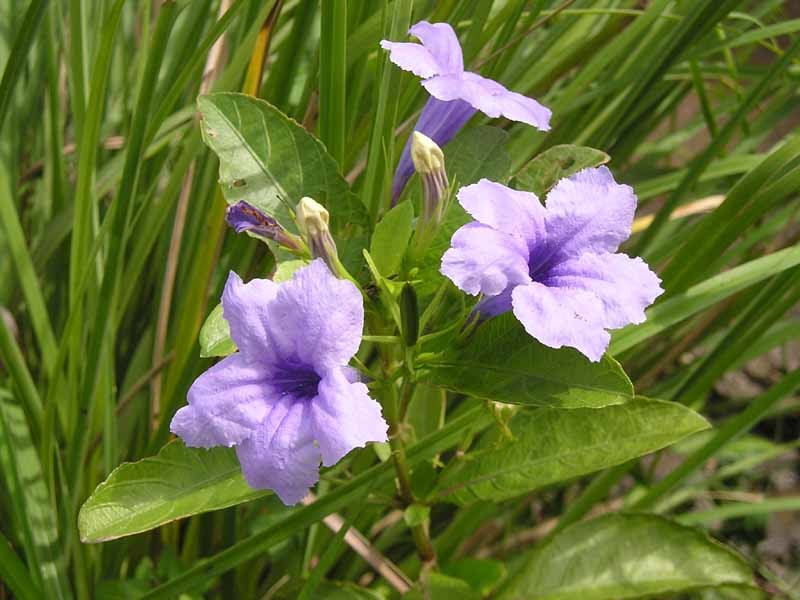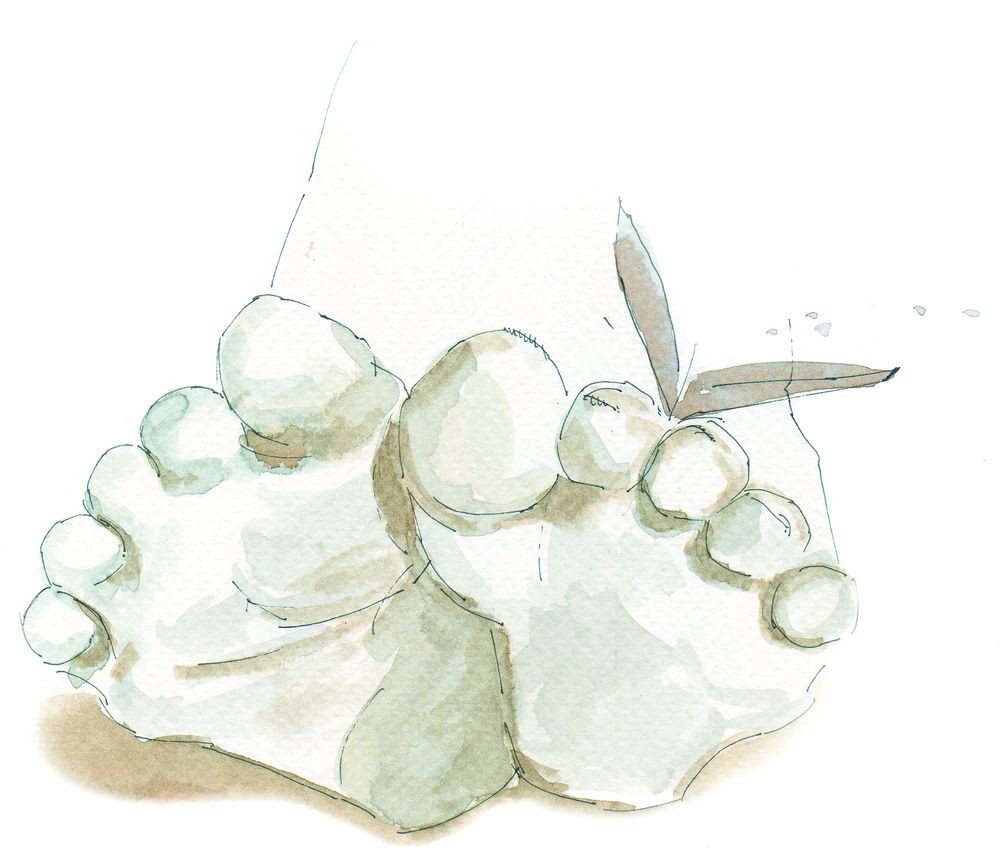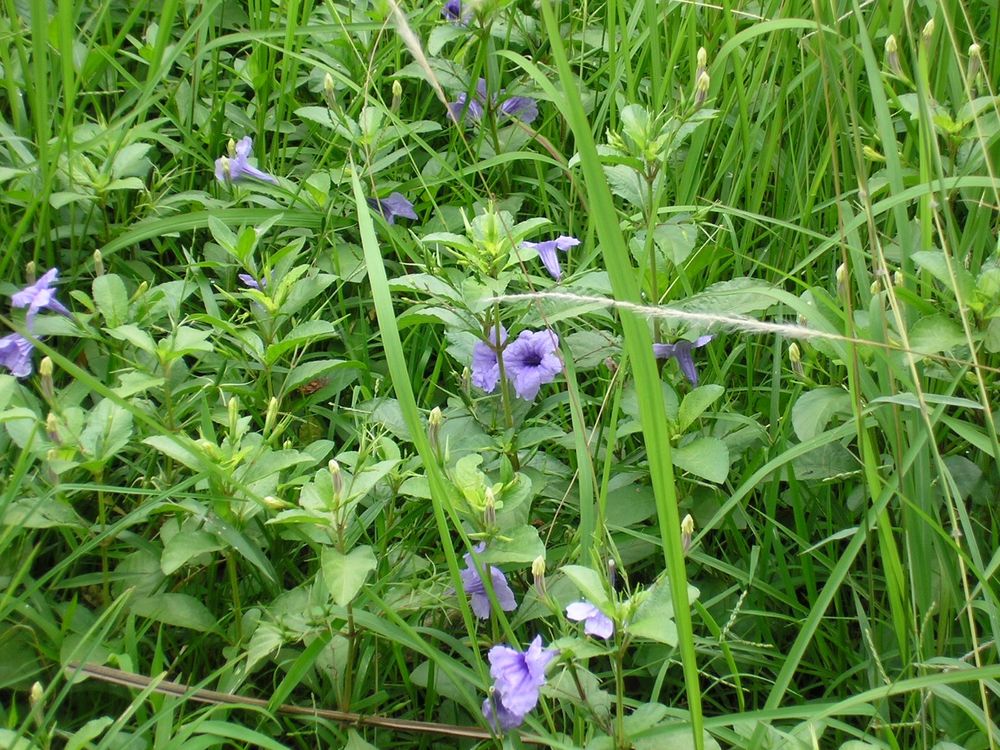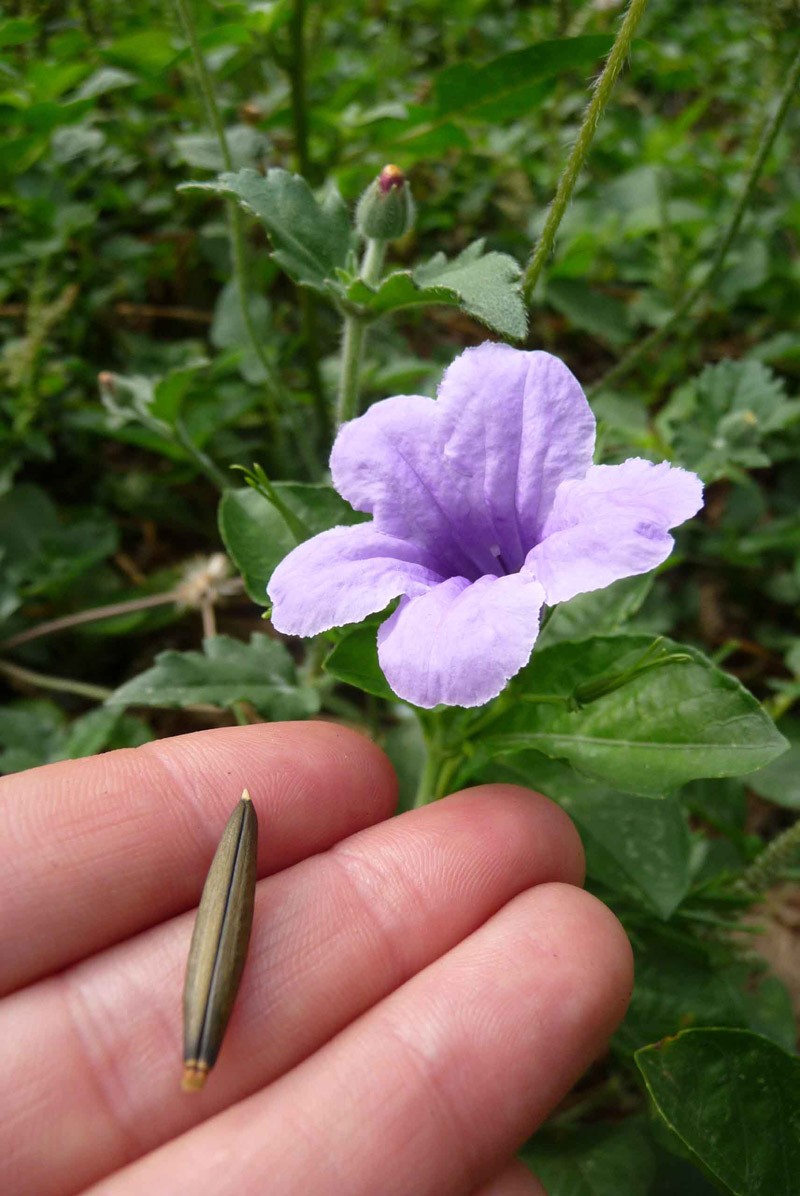This American plant is well naturalized in most tropical areas and in Laos where it has several names: bang ngop, hak pèp and more commonly bang sone which probably refers to the conical shape (bang) of its flowers; in Cambodian, its name would mean “heron excrement” which generally marks the insignificance of a plant; the English noted the fact that its fruits burst with noise (popping pod) and the French that the tuberous roots have the shape of “patate”; This is also expressed in the scientific name (tuberosa); as for the genus, it is dedicated to the French botanist and physicist Jean de la Ruelle (1474-1537) who taught at the Faculty of Medicine in Paris and was the physician of François I.
Bang sone is a grass a few dozen centimetres high that is mostly found in uncultivated fields among other weeds and sometimes mixed with crops. Its bundled roots are tinged with yellow and look like tubers. Its leaves are oval, opposite, dark green, with a finely toothed margin. The purple flowers are the most striking; they form conical tubes with 5 rounded petals. The fruit is a cylindrical capsule which bursts when drying, throwing its small black seeds far away.
The plant has been introduced into many tropical areas because it is considered medicinal: in Surinam, it is used to eliminate intestinal worms and to treat fractures, in Guyana it is used as an abortifacient, and in the West Indies, the roots are used for minor ailments, to treat coughs and to ‘clean the blood’. Closer to home, in Cambodia, a jelly produced from the wet seeds is applied to boils and cuts. In Laos, the whole plant is given as a decoction for coughs and whooping cough; a tea made from the leaves is used to combat excessive sweating and fever.
Children pick the fruit of dok bang sone at the edge of the road, wet it with saliva and are amused to see and hear it burst; the most mischievous insert it delicately between the toes of a grown-up who is having a nap and who is then startled; the plant is then called mak tèk, “the fruit that bursts”.
Cette plante américaine est bien naturalisée dans la plupart des zones tropicales et au Laos où elle a d’ailleurs plusieurs noms: bang ngop, hak pèp et plus couramment bang sone qui évoque sans doute la forme conique (bang) de ses fleurs; en cambodgien son nom signifierait «excrément de héron» ce qui marque en général l’insignifiance d’une plante; l’anglais a noté le fait que ses fruits éclatent avec bruit (popping pod) et le français que les racines tubéreuses ont la forme de « patate»; c’est aussi ce qu’exprime le nom scientifique (tuberosa); quant au genre il est dédié au botaniste physicien français Jean de la Ruelle (1474-1537) qui enseignât à la faculté de médecine de Paris et fut le médecin de François 1er.
Bang sone est une herbe haute de quelques dizaines de centimètres que l’on rencontre la plupart du temps dans des champs en friche au milieu d’autres mauvaises herbes et parfois mêlée aux cultures. Ses racines en faisceaux sont teintées de jaune et ressemblent à des tubercules. Ses feuilles sont ovales, opposées, vert foncé, avec une marge finement dentée. Ce sont ses fleurs violettes que l’on remarque surtout; elles forment des tubes coniques terminés par 5 pétales arrondis. Le fruit est une capsule cylindrique qui éclate en séchant projetant au loin ses petites graines noires.
Si cette plante a été introduite dans de nombreuses zones tropicales c’est parce qu’elle est considérée comme médicinale: au Surinam on l’emploie pour éliminer les vers intestinaux et pour soigner les fractures, en Guyane elle sert d’abortif, aux Antilles les racines sont employées contre les petits maux, pour soigner la toux et pour « nettoyer le sang ». Plus près de nous, au Cambodge, on applique sur les furoncles et les coupures une gelée produite par les graines mouillées. Au Laos, la plante toute entière est donnée en décoction en cas de toux, de coqueluche; une tisane faite avec les feuilles permettrait de lutter contre la transpiration excessive et la fièvre.
Les enfants cueillent au bord des chemins le fruit de dok bang sone, le mouillent de salive et s’amusent de le voir et de l’entendre alors éclater; les plus malicieux l’insèrent délicatement entre les orteils d’une grande personne qui fait sa sieste et qui sursaute alors; la plante se nomme alors mak tèk, « le fruit qui éclate ».




This American plant is well naturalized in most tropical areas and in Laos where it has several names: bang ngop, hak pèp and more commonly bang sone which probably refers to the conical shape (bang) of its flowers; in Cambodian, its name would mean “heron excrement” which generally marks the insignificance of a plant; the English noted the fact that its fruits burst with noise (popping pod) and the French that the tuberous roots have the shape of “patate”; This is also expressed in the scientific name (tuberosa); as for the genus, it is dedicated to the French botanist and physicist Jean de la Ruelle (1474-1537) who taught at the Faculty of Medicine in Paris and was the physician of François I.
Bang sone is a grass a few dozen centimetres high that is mostly found in uncultivated fields among other weeds and sometimes mixed with crops. Its bundled roots are tinged with yellow and look like tubers. Its leaves are oval, opposite, dark green, with a finely toothed margin. The purple flowers are the most striking; they form conical tubes with 5 rounded petals. The fruit is a cylindrical capsule which bursts when drying, throwing its small black seeds far away.
The plant has been introduced into many tropical areas because it is considered medicinal: in Surinam, it is used to eliminate intestinal worms and to treat fractures, in Guyana it is used as an abortifacient, and in the West Indies, the roots are used for minor ailments, to treat coughs and to ‘clean the blood’. Closer to home, in Cambodia, a jelly produced from the wet seeds is applied to boils and cuts. In Laos, the whole plant is given as a decoction for coughs and whooping cough; a tea made from the leaves is used to combat excessive sweating and fever.
Children pick the fruit of dok bang sone at the edge of the road, wet it with saliva and are amused to see and hear it burst; the most mischievous insert it delicately between the toes of a grown-up who is having a nap and who is then startled; the plant is then called mak tèk, “the fruit that bursts”.
Cette plante américaine est bien naturalisée dans la plupart des zones tropicales et au Laos où elle a d’ailleurs plusieurs noms: bang ngop, hak pèp et plus couramment bang sone qui évoque sans doute la forme conique (bang) de ses fleurs; en cambodgien son nom signifierait «excrément de héron» ce qui marque en général l’insignifiance d’une plante; l’anglais a noté le fait que ses fruits éclatent avec bruit (popping pod) et le français que les racines tubéreuses ont la forme de « patate»; c’est aussi ce qu’exprime le nom scientifique (tuberosa); quant au genre il est dédié au botaniste physicien français Jean de la Ruelle (1474-1537) qui enseignât à la faculté de médecine de Paris et fut le médecin de François 1er.
Bang sone est une herbe haute de quelques dizaines de centimètres que l’on rencontre la plupart du temps dans des champs en friche au milieu d’autres mauvaises herbes et parfois mêlée aux cultures. Ses racines en faisceaux sont teintées de jaune et ressemblent à des tubercules. Ses feuilles sont ovales, opposées, vert foncé, avec une marge finement dentée. Ce sont ses fleurs violettes que l’on remarque surtout; elles forment des tubes coniques terminés par 5 pétales arrondis. Le fruit est une capsule cylindrique qui éclate en séchant projetant au loin ses petites graines noires.
Si cette plante a été introduite dans de nombreuses zones tropicales c’est parce qu’elle est considérée comme médicinale: au Surinam on l’emploie pour éliminer les vers intestinaux et pour soigner les fractures, en Guyane elle sert d’abortif, aux Antilles les racines sont employées contre les petits maux, pour soigner la toux et pour « nettoyer le sang ». Plus près de nous, au Cambodge, on applique sur les furoncles et les coupures une gelée produite par les graines mouillées. Au Laos, la plante toute entière est donnée en décoction en cas de toux, de coqueluche; une tisane faite avec les feuilles permettrait de lutter contre la transpiration excessive et la fièvre.
Les enfants cueillent au bord des chemins le fruit de dok bang sone, le mouillent de salive et s’amusent de le voir et de l’entendre alors éclater; les plus malicieux l’insèrent délicatement entre les orteils d’une grande personne qui fait sa sieste et qui sursaute alors; la plante se nomme alors mak tèk, « le fruit qui éclate ».








This American plant is well naturalized in most tropical areas and in Laos where it has several names: bang ngop, hak pèp and more commonly bang sone which probably refers to the conical shape (bang) of its flowers; in Cambodian, its name would mean “heron excrement” which generally marks the insignificance of a plant; the English noted the fact that its fruits burst with noise (popping pod) and the French that the tuberous roots have the shape of “patate”; This is also expressed in the scientific name (tuberosa); as for the genus, it is dedicated to the French botanist and physicist Jean de la Ruelle (1474-1537) who taught at the Faculty of Medicine in Paris and was the physician of François I.
Bang sone is a grass a few dozen centimetres high that is mostly found in uncultivated fields among other weeds and sometimes mixed with crops. Its bundled roots are tinged with yellow and look like tubers. Its leaves are oval, opposite, dark green, with a finely toothed margin. The purple flowers are the most striking; they form conical tubes with 5 rounded petals. The fruit is a cylindrical capsule which bursts when drying, throwing its small black seeds far away.
The plant has been introduced into many tropical areas because it is considered medicinal: in Surinam, it is used to eliminate intestinal worms and to treat fractures, in Guyana it is used as an abortifacient, and in the West Indies, the roots are used for minor ailments, to treat coughs and to ‘clean the blood’. Closer to home, in Cambodia, a jelly produced from the wet seeds is applied to boils and cuts. In Laos, the whole plant is given as a decoction for coughs and whooping cough; a tea made from the leaves is used to combat excessive sweating and fever.
Children pick the fruit of dok bang sone at the edge of the road, wet it with saliva and are amused to see and hear it burst; the most mischievous insert it delicately between the toes of a grown-up who is having a nap and who is then startled; the plant is then called mak tèk, “the fruit that bursts”.
Cette plante américaine est bien naturalisée dans la plupart des zones tropicales et au Laos où elle a d’ailleurs plusieurs noms: bang ngop, hak pèp et plus couramment bang sone qui évoque sans doute la forme conique (bang) de ses fleurs; en cambodgien son nom signifierait «excrément de héron» ce qui marque en général l’insignifiance d’une plante; l’anglais a noté le fait que ses fruits éclatent avec bruit (popping pod) et le français que les racines tubéreuses ont la forme de « patate»; c’est aussi ce qu’exprime le nom scientifique (tuberosa); quant au genre il est dédié au botaniste physicien français Jean de la Ruelle (1474-1537) qui enseignât à la faculté de médecine de Paris et fut le médecin de François 1er.
Bang sone est une herbe haute de quelques dizaines de centimètres que l’on rencontre la plupart du temps dans des champs en friche au milieu d’autres mauvaises herbes et parfois mêlée aux cultures. Ses racines en faisceaux sont teintées de jaune et ressemblent à des tubercules. Ses feuilles sont ovales, opposées, vert foncé, avec une marge finement dentée. Ce sont ses fleurs violettes que l’on remarque surtout; elles forment des tubes coniques terminés par 5 pétales arrondis. Le fruit est une capsule cylindrique qui éclate en séchant projetant au loin ses petites graines noires.
Si cette plante a été introduite dans de nombreuses zones tropicales c’est parce qu’elle est considérée comme médicinale: au Surinam on l’emploie pour éliminer les vers intestinaux et pour soigner les fractures, en Guyane elle sert d’abortif, aux Antilles les racines sont employées contre les petits maux, pour soigner la toux et pour « nettoyer le sang ». Plus près de nous, au Cambodge, on applique sur les furoncles et les coupures une gelée produite par les graines mouillées. Au Laos, la plante toute entière est donnée en décoction en cas de toux, de coqueluche; une tisane faite avec les feuilles permettrait de lutter contre la transpiration excessive et la fièvre.
Les enfants cueillent au bord des chemins le fruit de dok bang sone, le mouillent de salive et s’amusent de le voir et de l’entendre alors éclater; les plus malicieux l’insèrent délicatement entre les orteils d’une grande personne qui fait sa sieste et qui sursaute alors; la plante se nomme alors mak tèk, « le fruit qui éclate ».


